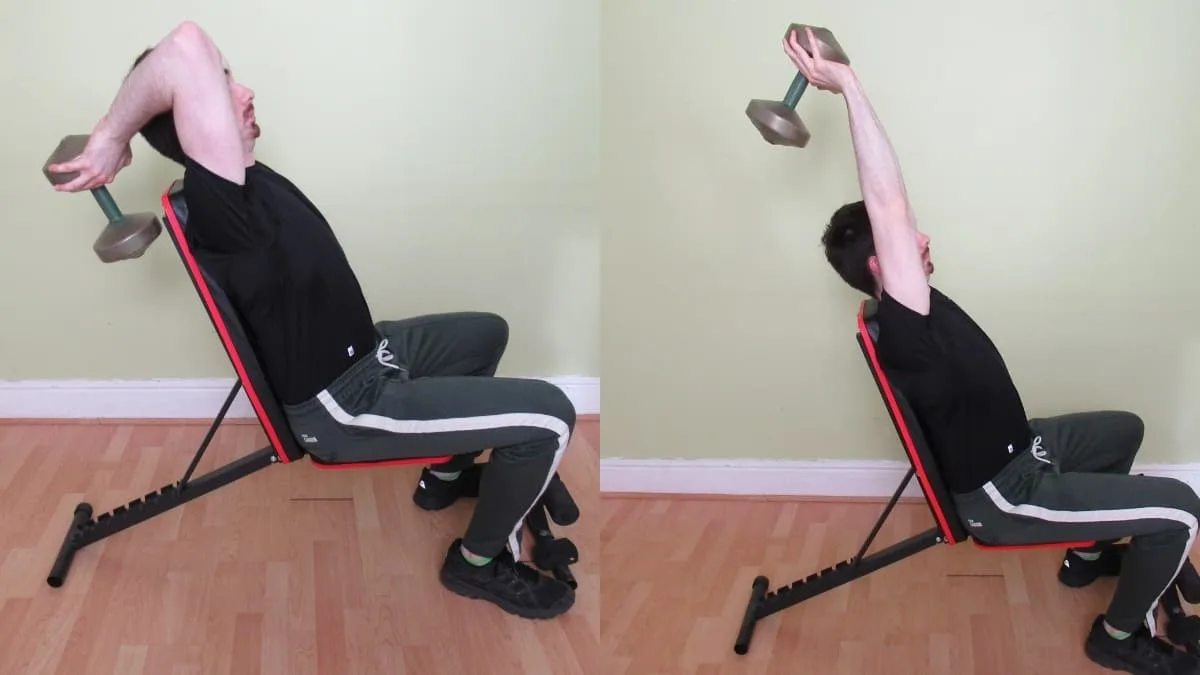The seated overhead dumbbell extension is a remarkable tricep isolation exercise. By sitting on a weight bench with your back braced against the pad, the core stability requirement of the extension becomes much lower. This, in turn, enables you to focus purely on training your triceps, which ultimately results in a better muscle pump and a more potent hypertrophic stimulus.
This guide covers 4 seated tricep press variations and then discusses the pros and cons of seated tricep extensions in general. After that, you’ll learn how many reps and sets of the seated dumbbell extension you should be doing and at what frequency.
Seated dumbbell tricep extension exercise details
- Also Known As: Seated triceps press, sitting tricep extension
- Main Muscles: Triceps
- Exercise Type: Strength
- Exercise Mechanics: Isolation
- Difficulty Level: Beginner
- Equipment Needed: Dumbbell, bench
How to do a seated tricep extension with dumbbells
- Position the backrest of a weight bench to a 90-degree angle. Alternatively, use a bench with a fixed back pad.
- Grab a moderately heavy dumbbell and cup your hands around one end of the weight.
- Press the dumbbell over your head and tuck your elbows in slightly.
- Bend your elbows to lower the dumbbell behind your head.
- Keep going until you feel an intense triceps stretch (for most people, this will be when their forearms and biceps make firm contact at the bottom of the rep).
- Reverse the movement by flexing your triceps until your arms are fully extended.
- Repeat for 3-5 sets of 8-20 reps.
Seated dumbbell extension variations
There are multiple seated tricep extension variations that you can do to work your muscles from different angles and with various other equipment. For example, you could do the seated barbell tricep extension if you want an exercise that’s highly conducive to progressive overload.
Similarly, you could perform the seated cable tricep extension if you want to challenge your triceps with constant tension, a training style that’s especially effective for finishing your muscles off at the end of the workout.
The following variations, however, are all types of seated dumbbell tricep extensions.
Seated overhead tricep extension (two dumbbells)
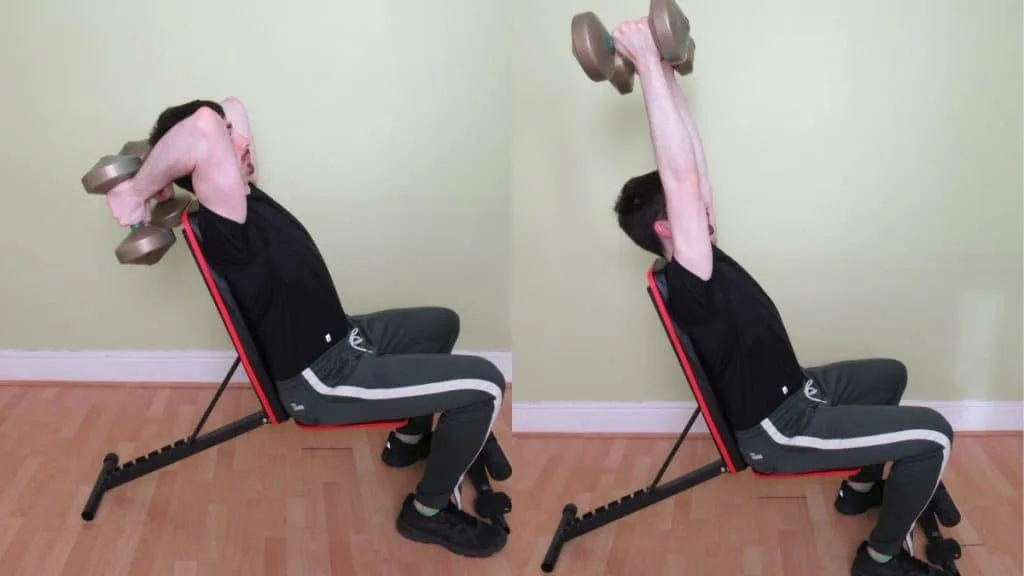
While the seated dumbbell overhead triceps extension is undeniably effective for building triceps size, it’s not the best exercise for sculpting triceps symmetry.
This is because when you’re lifting the same weight with both arms, there’s a high chance that your stronger triceps muscle will do more of the lifting. Thus, muscular imbalances are likely to develop and become more pronounced over time unless you train each of your triceps independently.
The solution is remarkably simple.
Instead of lifting the same weight with both arms, you’re going to lift a separate dumbbell in each hand. With this isolateral setup, your stronger arm can’t dominate the movement because it’s already preoccupied with holding its own dumbbell.
As such, both of your triceps will grow in proportion because they’ll be receiving similar amounts of stimulation. Of course, you may still have a stronger mind-muscle connection with one of your triceps, in which case that particular muscle will still get a better workout.
Performing a one arm seated dumbbell extension, where you train each arm completely separately, is the most effective way to prevent triceps size asymmetries because you can really hone in on each of your triceps and improve your mind-muscle connection.
Reverse grip seated dumbbell overhead extension

Reverse overhead triceps extensions encourage you to keep your elbows tucked in because when most people supinate their palms, their elbows naturally move toward their sides.
The problem is that since the triceps only act on the elbow (with the exception of the long head, which also acts on the shoulder joint), using a reverse grip doesn’t actually force you to tuck your elbows. In fact, it’s entirely possible to rotate your hands back and forth without your elbows moving an inch.
Therefore, the reverse grip seated triceps extension offers no advantage in muscle activation or exercise safety. If anything, using a reverse grip actually makes it harder to hold the weights, which is the last thing that you want when you’re holding the dumbbells over your head.
So, considering that performing a two arm seated dumbbell extension naturally entails using a close grip (which, in turn, helps you to keep your elbows tucked), you should stick to a neutral grip when using two weights or the cupped hand position when using a single dumbbell.
Alternating seated overhead extension
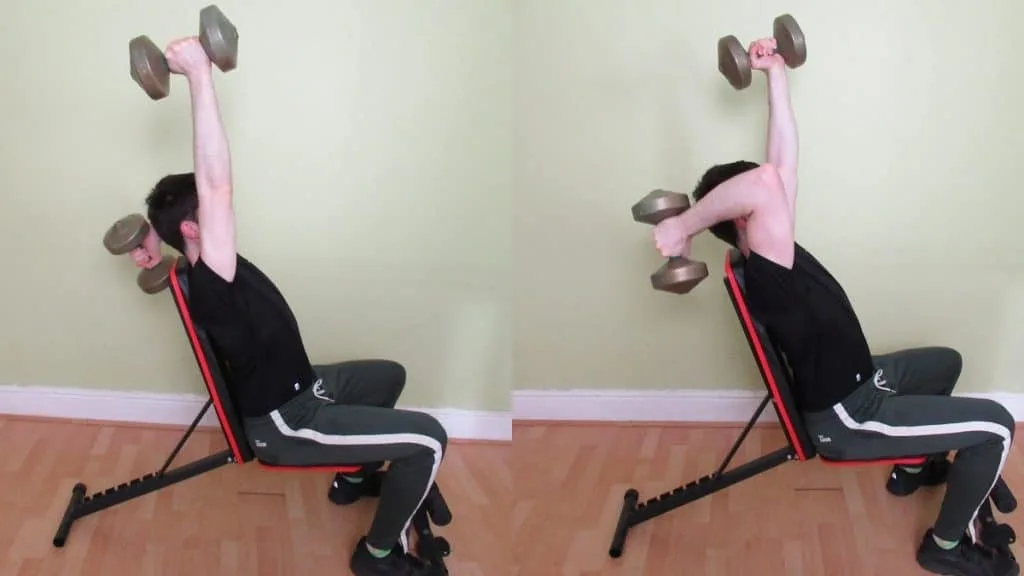
The seated overhead triceps extension is an underrated exercise that has one significant benefit.
The seated extension increases your training volume by enabling you to perform extra reps on every set.
This is because when you train your triceps in an alternating fashion, your muscles are actually getting a brief rest period after each of their reps. So by the time they need to contract again, they’re naturally fresher and stronger because they’ve had a chance to recuperate.
To get this benefit, however, you need to keep your non-working arm locked out so that it’s not doing any lifting. If you let it stretch behind your head, then it won’t be getting any kind of rest and will, in fact, be more fatigued than usual because weighted stretches are very challenging to maintain.
You could, of course, use the latter scenario as an intensity technique: Perform all your reps with one arm while the triceps muscle of your other arm is being stretched behind your head. Then swap sides.
Seated tricep press pros and cons
As effective as the seated dumbbell tricep press is for building arm size, there are still some drawbacks that you need to take into account before deciding whether or not the exercise is right for you.
Pro: Enhanced mind-muscle connection
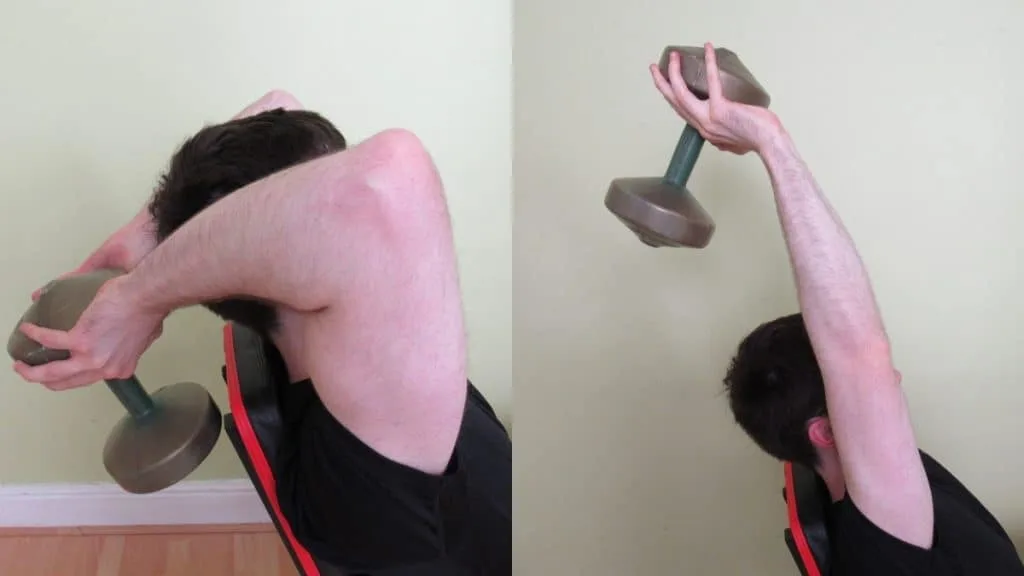
Exercises like standing kettlebell tricep extensions can certainly build mass. The problem, however, depending on your point of view, is that standing exercises require greater abdominal exertion.
Having to flex your abs to keep your torso stable can make it harder to focus on training your triceps. Since the seated two arm dumbbell extension is a pure isolation exercise, it doesn’t make sense to work your abs at the expense of your triceps, especially when you’re training primarily for hypertrophy.
Of course, if you’ve already developed a solid mind-muscle connection through years of triceps training, then you might not find much difference between the seated and standing variations. You may, in fact, relish the extra core activation because if you lift heavy enough, then your abs really do get a tremendous isometric workout.
Most bodybuilders, however, opt for the sitting dumbbell tricep extension because it takes their other muscles more or less out of the equation. Thus, they can dedicate all of their energy to training the actual target muscles of the seated overhead extension: the triceps brachii.
Pro: Builds bigger arms
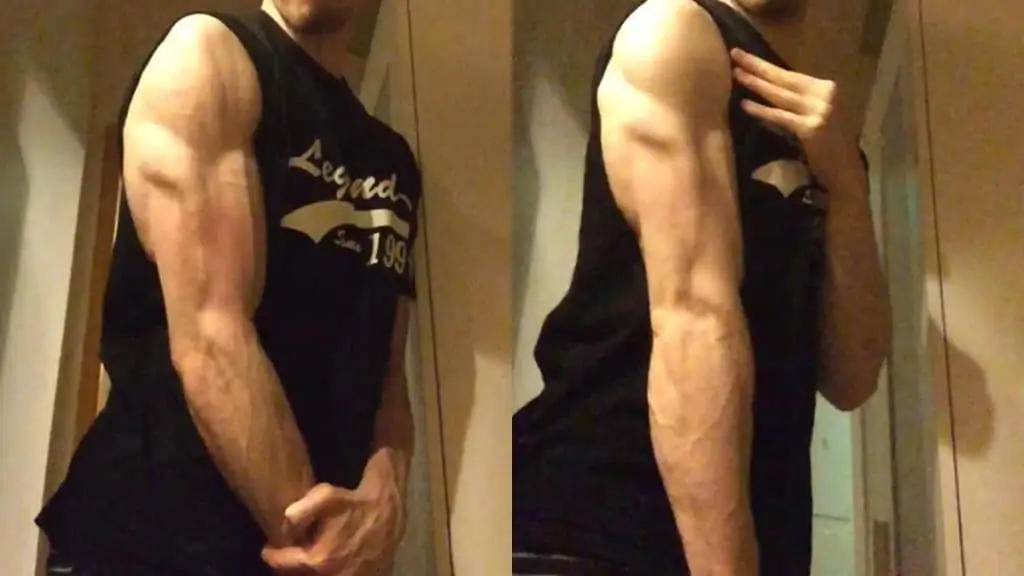
Did you know that the long head of the triceps is bigger than the lateral and medial heads combined?
Well, combine this information with the fact that the triceps (as a whole) account for two-thirds of your upper arm mass, and you can see why the long head deserves plenty of attention; it’s the most crucial arm muscle for gaining size.
Since the long head crosses the shoulder joint whereas the other two heads don’t (this may explain the long head’s size), you need to train it when your shoulders are in flexion or extension to get the best results.
Because the seated overhead tricep extension puts your shoulders in maximum flexion, it’s just about the most effective exercise for maximizing long head development, especially because it allows for heavy lifting (unlike, say, kickbacks, which work the long head from a different angle—shoulder extension).
Pro: Great for gaining strength
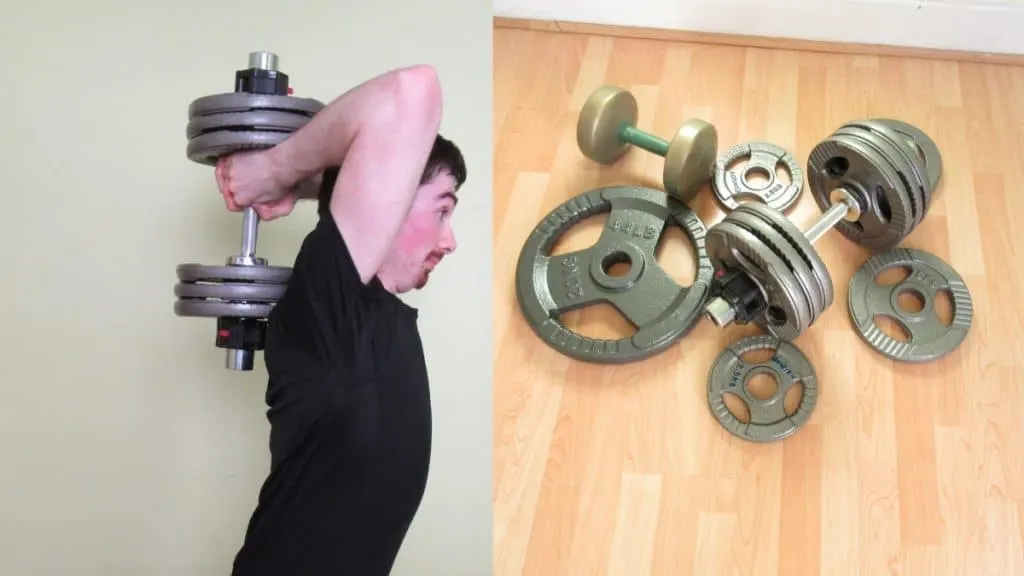
Many coaches correctly note that dumbbells are suboptimal for gaining strength because the increments can often be 5 lbs per side. This is a considerable amount of resistance when you’re training a relatively small muscle group like the triceps.
Yet, with the seated overhead tricep extension, making massive weight jumps isn’t an issue because you’re lifting the same weight with both arms. As such, you only need to bump up the resistance by 5 lbs in total rather than 5 lbs per side, which makes it much easier to gain triceps strength on a regular basis.
The seated EZ bar tricep extension is another good exercise in this regard because you can increase the weight in even more manageable increments by using small weight discs and even fractional plates.
Con: Lower calorie burn
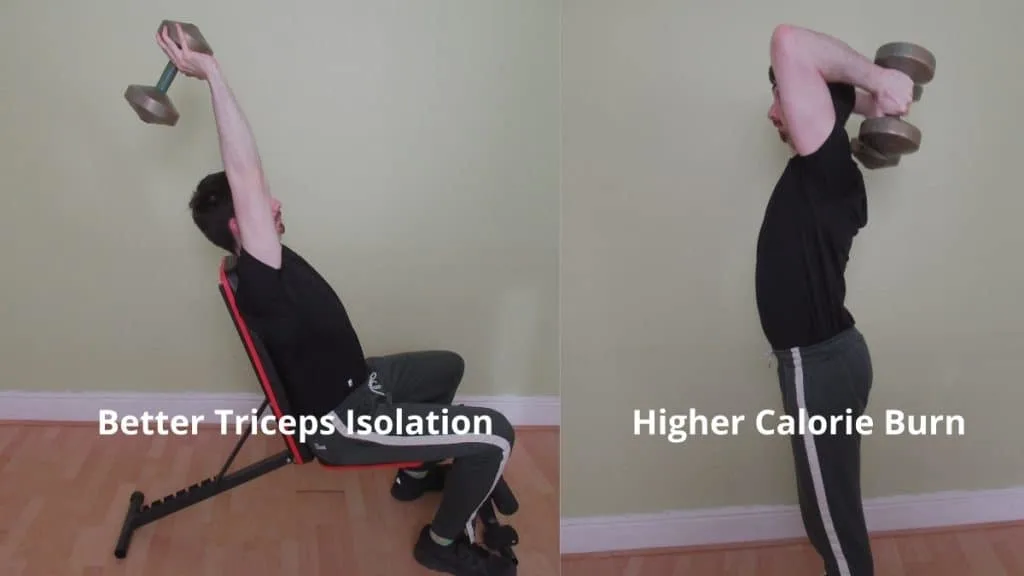
For hypertrophy-focused lifters, calorie expenditure is a side-effect of training rather than the primary goal of it.
In fact, if you’re trying to gain mass, then you may actually want to limit your energy expenditure in the gym by performing your isolation exercises in seated positions rather than doing them standing up.
Yet, if you’re in a cutting phase or simply want to maximize your calorie burn during training, then it makes sense to perform your tricep extensions in a standing position so that your leg and abdominal muscles are active.
Movements that require greater core stability lead to greater energy expenditure, which is why the resistance band tricep extension isn’t the best exercise for burning calories, despite being incredibly effective for training the triceps.
Like many exercises in fitness, the seated triceps press is neither optimal nor suboptimal; its ultimate effectiveness depends primarily on your training goals.
Con: Less core activation

The seated dumbbell overhead extension demands less of your core than the standing version because the backrest of the bench stabilizes your torso.
From a hypertrophy perspective, the reduced abdominal activation is actually a good thing because it’ll allow you to dedicate 100% of your attention to training your triceps, which is the whole point of a tricep extension.
On the other hand, some people like to train their core at every opportunity. After all, you’d be pretty hard pushed to make your core too strong.
So again, it depends on you. If you want to keep the tension on your triceps, then stick with the seated dumbbell overhead tricep extension. But if you want to give your abs a good isometric workout in the process of training your tris, then do your extensions standing up.
Swiss ball dumbbell overhead tricep extensions are a good middle ground in this respect because they demand greater core stability than the seated extension but not as much ab activation as the standing version.
Con: Requires good shoulder mobility

The seated tricep press places your shoulders into the highest possible degree of flexion. As mentioned, this shoulder positioning places the long head under an intense eccentric stretch that primes your triceps for muscle growth.
As great as muscle activation is, some people simply lack the shoulder mobility to get their arms over their head.
If this is you, then give incline dumbbell overhead extensions a try.
In general, the more upright your torso is when your shoulders are flexed, the more discomfort you’ll feel. So taking the bench angle down a notch or two can often help people to get their arms behind their head and thus maximize the effectiveness of the seated tricep extension.
Sitting tricep extension sets and reps
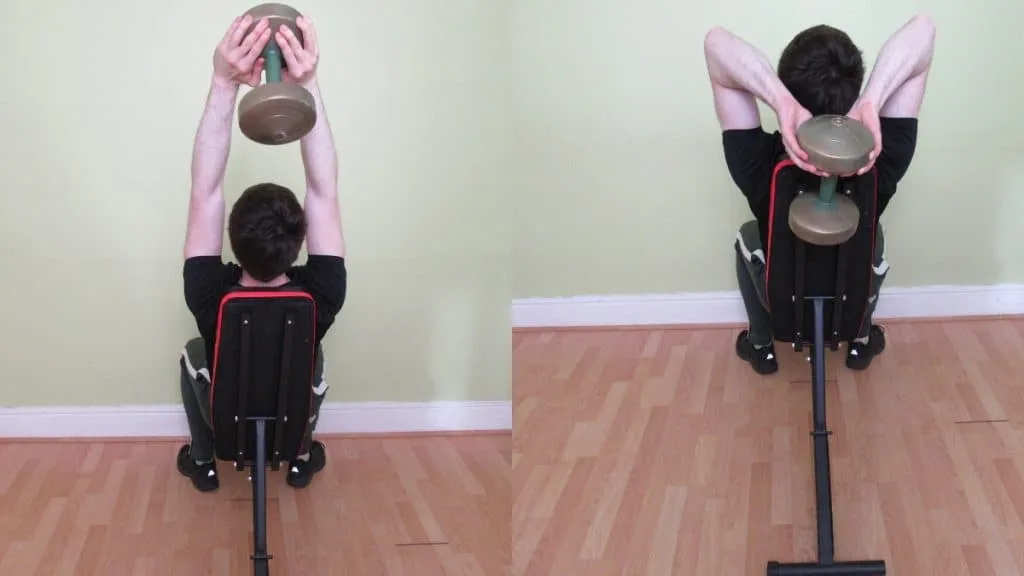
Most people should perform 3-6 sets of seated triceps extensions per session.
Perform 8-20 reps on each set.
There’s no single best rep range for gaining muscle because your triceps, as simple pieces of meat, don’t have an inbuilt rep counter, and they certainly can’t read the number on the side of the dumbbell. As such, you should try multiple rep ranges to see which gives you the best bang for your buck.
In general, higher reps are easier on the joints, but they tend to create more systemic fatigue.
Low reps, since they demand a lot from your central nervous system, can also create large amounts of systemic fatigue (less so on isolation exercises). Additionally, low rep lifting places considerably more torque through your joints than high rep training because you’ll naturally be using heavier weights.
For these reasons, the majority of strength trainees get good long-term results by performing the seated dumbbell extension for moderate reps (8-15).
Aim to perform the seated dumbbell tricep extension 1-2 times per week. You can train your triceps more frequently than this if it makes sense given your level of advancement, but since exercises like sitting dumbbell triceps extensions and the plate tricep extension place significant torque on the elbow joints, the training frequency for overhead movements should ideally be limited to twice weekly unless you’re training with high reps.
Conclusion: How effective is the seated dumbbell triceps extension?
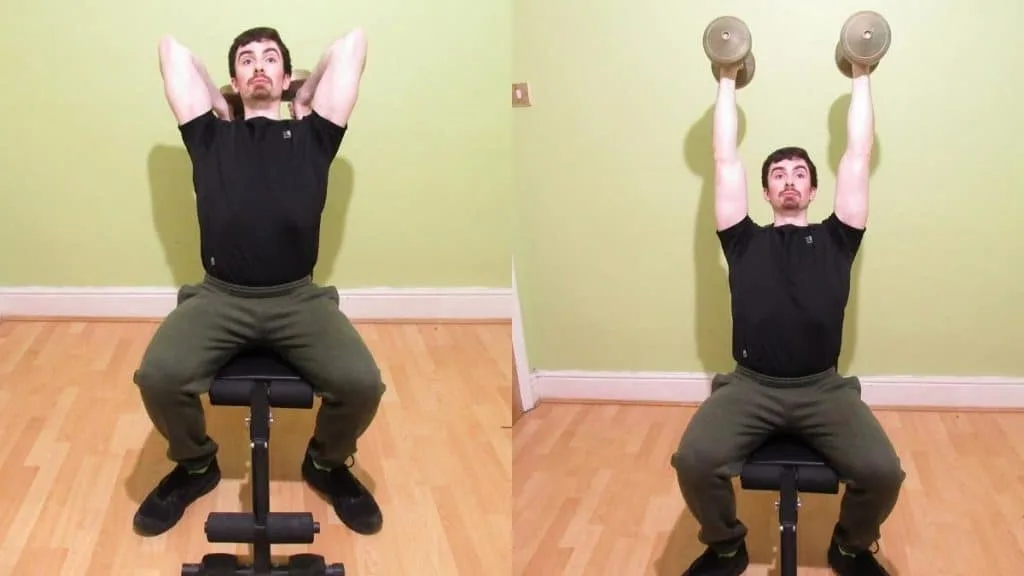
The seated tricep extension is a highly effective muscle-building exercise. Since your torso is stabilized by the backrest of the bench, you can more easily focus on training your triceps (the whole point of this isolation exercise) because you don’t have to put so much effort into bracing your core.
Since the seated overhead tricep extension places the long head of the triceps under an intense eccentric stretch—more so than most comparable movements—it’s naturally an excellent exercise for stimulating hypertrophy because the eccentric portion of the rep is essential for muscle growth.

